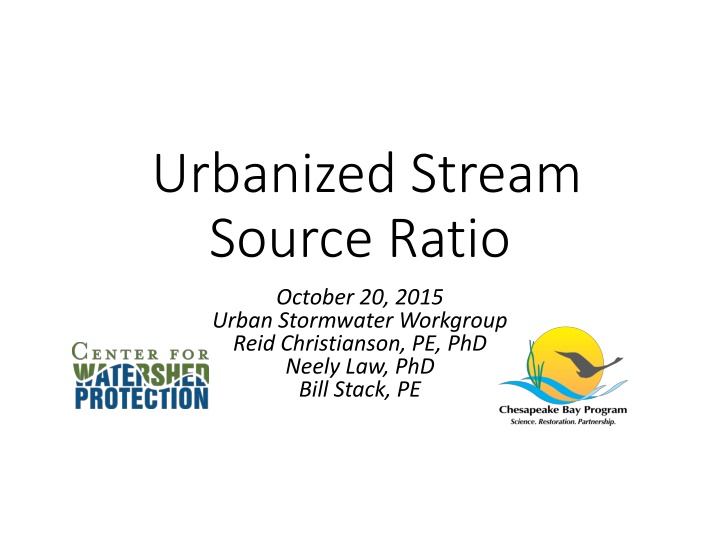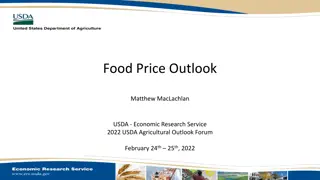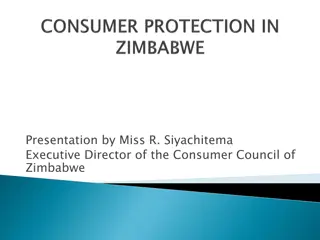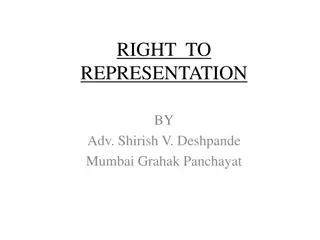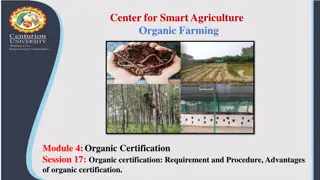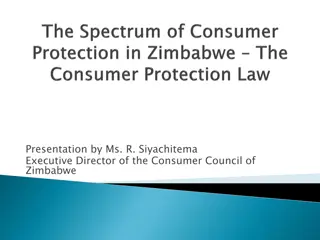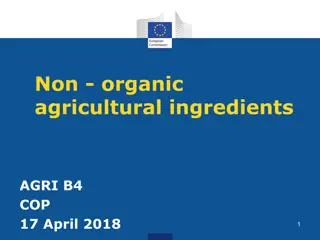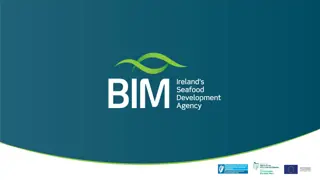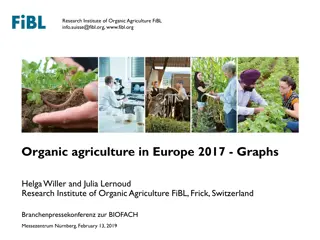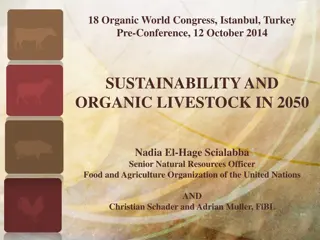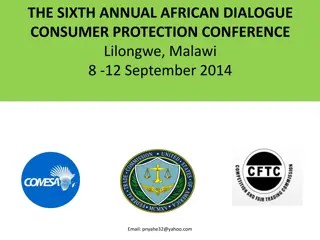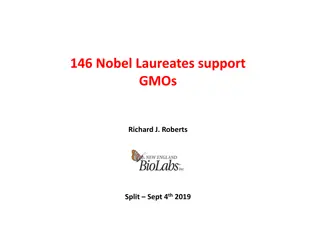GMOs, Organic Food, and Consumer Choices
Genetically Modified Organisms (GMOs) are a controversial topic, with proponents citing benefits like increased crop resilience and nutritional value, while opponents raise concerns about health risks and environmental impact. Organic food offers a natural alternative, promoting biodiversity and sustainable farming practices. The decision between GMOs and organic food is complex, with nuances in consumer preferences and scientific evidence influencing choices. Ultimately, prioritizing a diet rich in fruits and vegetables, whether organic or GMO, is essential for a healthy lifestyle.
Download Presentation

Please find below an Image/Link to download the presentation.
The content on the website is provided AS IS for your information and personal use only. It may not be sold, licensed, or shared on other websites without obtaining consent from the author.If you encounter any issues during the download, it is possible that the publisher has removed the file from their server.
You are allowed to download the files provided on this website for personal or commercial use, subject to the condition that they are used lawfully. All files are the property of their respective owners.
The content on the website is provided AS IS for your information and personal use only. It may not be sold, licensed, or shared on other websites without obtaining consent from the author.
E N D
Presentation Transcript
Urbanized Stream Source Ratio October 20, 2015 Urban Stormwater Workgroup Reid Christianson, PE, PhD Neely Law, PhD Bill Stack, PE
Background Need identified to better represent headwater streams in the Phase 6 Bay Watershed Model Peculiarities of Perviousness STAC workshop (Nov. 2013) Called for consideration of stream corridor as a separate land use Focus on urban watersheds below 60 square miles (0 to 3rdorder) 2
Current representation of streams in Phase 5 Chesapeake Bay Watershed Model Edge-of-Field Expected loads from one acre Loads from headwater streams considered a part of upland areas Some Watershed BMPs Edge-of-Stream 60-100 sq miles SDF In Stream Concentrations 3
Key Findings NSQD database TSS concentrations from urban land uses lower than what is observed in urban streams, suggesting that other downstream sources are also responsible for the urban sediment budget Research studies Urban stream channel erosion is a major component of the urban sediment budget; 20 60% on average Magnitude of stream channel erosion in any given urban watershed are strongly influenced by local factors, such as watershed impervious cover and the physical properties of the urban stream corridor 4
Previous Work Phase I Literature Review (CWP, 2013 & 2014a) Phase II MS4 Concentration Monitoring Data (CWP, 2014b) Phase III Watershed Flow-Concentration Relations (CWP, 2015) 5
Previous Work Phase I Literature Review (CWP, 2013; CWP 2014a) 38 entries; 16 included % sediment from in-stream; 9 met size criteria (<60 sq. mi.) Histogram of the percentage of sediment load from instream two outliers and modeling studies removed. 6
Previous Work Phase II MS4 Concentration Monitoring Data (CWP, 2014) 7
General Approach Define a Stream Source Ratio (SSR) that quantifies the relative load attributed to in- stream sources (e.g. bed & bank erosion, resuspension) ??? & ???? ??????? ??? & ???? ??????? + ??????= ???????? ?????? ?? ??? = 8
Urban streams In densely developed areas where streams systems are heavily altered, the contribution of erosion* to sediment yield can be estimated based on a Stream Source Ratio (SSR) of observed sediment concentrations in outfalls vs streams. * Including erosion from banks, beds, and resuspension of sediment. Upland Sources Watershed Sources
General Mass Balance Approach ?????? ?? ???????? ???? = ?????? ???????????? + ???????? ???????????? ???????? ???????????? = ?????? ?? ???????? ???? ?????? ???????????? Watershed Flow-Load relations for watershed as a whole Use CBWM hourly flow as proxy for monitored flow Upland Mean upland sediment concentration County specific, from National Stormwater Quality Database, where available 10
Analytical Process SSR estimated as a result Monitoring data from small urban watersheds Event Mean Concentration from NSQD Relate drainage area characteristics to SSR E.g. Impervious & Soil type Final predictive regression based on 6 watersheds 11
Watershed Characteristics WATERSHED NAME DRAINAGE AREA (SQ. MI.) IMPERVIOUS COVER (FRACTION) FOREST COVER (FRACTION) FRACTION HSG C/D RIPARIAN LENGTH FRACTION OF STREAM SSR (ESTIMATED) BREEWOOD 0.10 0.331 0.181 0.729 1.00 0.820 MOORES RUN @ RADECKE AVE STONY RUN @ LINKWOOD WEST BRANCH HERRING RUN @ IDLEWYLDE SCOTT'S LEVEL - 01 POWDER MILL RUN 3.52 0.300 0.070 0.895 0.750 0.579 2.20 0.694 0.306 0.438 0.385 0.909 2.13 0.277 0.116 0.449 0.405 0.319 3.42 0.246 0.029 0.641 0.767 0.314 3.64 0.378 0.041 0.954 0.656 0.691 12
Flow-Load Relation ??? ? ????? ??????????? ??= ????? 13
Flow-Load Relation ??? ? ????? ??????????? ??= ????? ????????? ???????? ???? = ?????? ???????????? + ???????? ???????????? 14
SSR Estimation Example - Watershed Flow-load relation used to estimate total watershed load Average Annual Load (lbs) Upland Load Corridor Load SSR ????????? ???????? ???? = ?????? ???????????? + ???????? ???????????? 4,561,082 416,273 4,144,809 lbs/yr lbs/yr lbs/yr 0.9087 15
SSR Estimation Example - Upland Event Mean Concentration for county from NSQD represents upland ???????(??????) = ???????? ????????? Linkwood Fraction Impervious 0.694 ?????? ?? ???????? ???? = ?????? ???????????? + ???????? ???????????? OUTFALLS Watershed Average Annual Load (lbs) Upland Load Corridor Load SSR 4,561,082 416,273 4,144,809 lbs/yr lbs/yr lbs/yr TSS Storm EMC Mean mg/L 40 0.9087 Surface Flow (in/ac/hr) Baseflow & Interflow (in/ac/hr) 560.7 124.3 Mean Load (lbs/ac) 6,208.6 Annual Loads Mean (lbs/ac/year) 295.6 Total annual load 416,273 lbs 16
SSR Estimation Example - Upland Event Mean Concentration for county from NSQD represents upland ???????(??????) = ???????? ????????? Linkwood Fraction Impervious 0.694 ?????? ?? ???????? ???? = ?????? ???????????? + ???????? ???????????? OUTFALLS Watershed Average Annual Load (lbs) Upland Load Corridor Load SSR Watershed Breewood Moored Run @ Radecke Ave Stony Run @ Linkwood West Branch Herring Run @ Idlewylde Scott's Level - 01 Powder Mill Run 4,561,082 416,273 4,144,809 lbs/yr lbs/yr lbs/yr TSS Storm EMC Mean mg/L 40 0.9087 Upland TSS EMC (mg/l) 58.0 44.0 40.0 40.0 32.4 40.0 Surface Flow (in/ac/hr) Baseflow & Interflow (in/ac/hr) 560.7 124.3 Mean Load (lbs/ac) 6,208.6 Annual Loads Mean (lbs/ac/year) Average 42.4 295.6 Total annual load 416,273 lbs 17
SSR Estimation Example - Instream ???????? ???????????? = ?????? ?? ???????? ???? ?????? ???????????? (Watershed) Average Annual Load (lbs) Upland Load Corridor Load SSR 4,561,082 416,273 4,144,809 lbs/yr lbs/yr lbs/yr (Instream) 0.9087 18
SSR Estimation Example - Instream ???????? ???????????? = ?????? ?? ???????? ???? ?????? ???????????? (Watershed) Average Annual Load (lbs) Upland Load Corridor Load SSR 4,561,082 416,273 4,144,809 lbs/yr lbs/yr lbs/yr (Instream) 0.9087 19
Scotts Level MS4 Report for 2011 Annual Average (flow-load) = 480,195 lbs = 480,183 lbs 20
Final Simplified Predictive Regression ??? = 1.4085 ?????????? ????? ???????? + 0.5341 ??? ??(????????) 0.2828 Watersheds with 25% impervious or more 21
Final Simplified Predictive Regression ??? = 1.4085 ?????????? ????? ???????? + 0.5341 ??? ??(????????) 0.2828 Trib. to Big Spring Run ~ 1.05 sq. mi. @17.6% Imp. & 27% HSG CD 22
Final Simplified Predictive Regression ??? = 1.4085 ?????????? ????? ???????? + 0.5341 ??? ??(????????) 0.2828 Allen Creek ~ 27.27 sq. mi. @13.7% Imp. & 64% HSG CD 23
Phase 6 Implementation RUSLE based on work by USGS and Tetra-Tech represents upland load Impervious cover would contribute no sediment Apply the predicted SSR and back-calculate sediment from stream Sediment EMCs Upland loads calculated on-the-fly with modeled flow Tetra Tech NSQD and Literature EMC (140.44 mg/l) CWP Maryland MS4 analysis EMC (92.21 mg/l) NSQD Bay States average (CWP, 2014) EMC (72.77 mg/l) Apply the predicted SSR and back-calculate sediment from the stream Phase 5.3.2 total load (fallback) SSR to parse load into upland and stream 24
Rural Streams (<15% Imp.) - USGS Spatial analysis estimating Stream Parameters Sediment balance based on USGS monitoring data 25
Questions? References Center for Watershed Protection. 2013. Technical Memorandum: Sediment Stream Loading Literature Review in Support of Objective 1 of the Sediment Reduction and Stream Corridor Restoration Analysis, Evaluation and Implementation Support to the Chesapeake Bay Program Partnership. Center for Watershed Protection. 2014a. Technical Memorandum: Stream Sediment Studies in Support of Objective 1 of the Sediment Reduction and Stream Corridor Restoration Analysis, Evaluation and Implementation Support to the Chesapeake Bay Program Partnership. Center for Watershed Protection. 2014b. Technical Memorandum: Analysis of Stream Sediment Monitoring in Support of Objective 1 of the Sediment Reduction and Stream Corridor Restoration Analysis, Evaluation and Implementation Support to the Chesapeake Bay Program Partnership. Center for Watershed Protection. 2015. Technical Memorandum: Analysis of Stream Sediment Monitoring to create a watershed characteristic regression in Support of Objective 1 of the Sediment Reduction and Stream Corridor Restoration Analysis, Evaluation and Implementation Support to the Chesapeake Bay Program Partnership. 26
Predicted SSR for Small Urban Streams General envelope of potential SSR results 27
